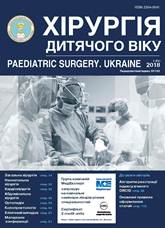Epidemiology of children’s burns in Kyiv
DOI:
https://doi.org/10.15574/PS.2018.59.21Keywords:
children, burns, epidemiology, child burn injury rateAbstract
Objective – to conduct clinical and statistical analysis of burns in children over a 3-years period, to identify key epidemiological factors that form the structure of children's burn injuries in Kyiv.Material and methods. The analysis of clinical care and treatment outcomes in 2437 children aged from the first months to 18 years with thermal injuries in Kyiv City Clinical Hospital No.2 for 2015-2017 was carried out. The objects of the study were the accounting forms of medical documentation: a statistical card of discharged patient and clinical charts.
Results. In recent years, there has been a persistently high level of child burn injury rate, which is due to the demographic situation in Kyiv – the increase in the birth rate and the geographic population shift from other regions of Ukraine. The burn injury rate is influenced by the children's age – the majority of injured children (87%) were aged from 0 to 3 years. Most common type of burns in children is scald burns (78.5%); the 2nd place (16%) is occupied by contact burns. Burns from flame made up 3.2%, electrical burns – 1.3%, and chemical burns – 1%. The number of severe burns among the child population of Kyiv has been fallen by half over the past 10 years. The mortality rate has been reduced to 0.16.
Conclusions. The conducted clinical and statistical analysis of the treatment of burns in children over a 3-year period allowed establishing that the most desirable years of burns in children are from 1 month to 3 years. The influence of social factors (parent’s care) was found on the formation of children’s burn injury rate in Kyiv. The leading aetiologic factor in the structure of children’s burn injuries is boiling water. Every fifth child with burns is hospitalized for treatment in the intensive care unit. Analysis of these factors provides a basis for continuing the work of the current targeted programs on prevention and treatment of burn injuries in children.
References
Kovalenko OM, Kozynets HP, Kovalenko AO. (2015). Vybir ranovykh pokryttiv pry likuvanni poverkhnevykh opikiv. Klinichna khirurhiia. 11.2: 58-59.
Kovalenko OM. (2012). Patohenetychne obgruntuvannia prohram khirurhichnoho likuvannia ditei z poshyrenymy opikamy ta yikh vplyv na perebih ranovoho protsesu. Kyiv.
Bousema S, Stas HG, van de Merwe MH, Oen IM, Baartmans MG, van Baar ME. (2016, Sep). Epidemiology and screening of intentional burns in children in a Dutch burn centre.; Dutch Burn Repository group, Maasstad Hospital Rotterdam. Burns. 42(6): 1287-94. https://doi.org/10.1016/j.burns.2016.01.009.
Child Safety and Injury Prevention: Burn Prevention. Centers for Disease Control and Prevention; Atlanta, GA, USA. (2016). https://www.cdc.gov/safechild/burns/index.html.
Elton Mathias, Madhu Srinivas Murthy (2017). Pediatric Thermal Burns and Treatment: A Review of Progress and Future Prospects. Medicines (Basel). 4(4): 91. https://doi.org/10.3390/medicines4040091; https://doi.org/10.20944/preprints201711.0204.v1. https://www.ncbi.nlm.nih.gov/pmc/articles/PMC5750615 /
Michael H Toon, Dirk M Maybauer, Lisa L Arceneaux, John F Fraser, Walter Meyer, Antoinette Runge, Marc O Maybauer. (2011). Children with burn injuries-assessment of trauma, neglect, violence and abuse. J Inj Violence Res. 3(2): 98–110. https://doi.org/10.5249/jivr.v3i2.91.
Stoddard FJ, Ronfeldt H, Kagan J, Drake JE, Snidman N, Murphy JM, Saxe G, Burns J, Sheridan RL. (2006). Am J Psychiatry. Young burned children: the course of acute stress and physiological and behavioral responses. 163(6): 1084-90. Doi 10.1176/ajp.2006.163.6.1084
Vijay Krishnamoorthy, Ramesh Ramaiah, Sanjay M Bhanankerint. (2012). J Crit Illn Inj Sci. Pediatric burn injuries. 2(3): 128–134. https://doi.org/10.4103/2229-5151.100889; PMid:23181206 PMCid:PMC3500004
World Health Organisation. (2017). Burns, fact sheet. A WHO plan for Burn Prevention and Care. http://www.who.int/mediacentre/factsheets/fs365/en.
Downloads
Issue
Section
License
The policy of the Journal “PAEDIATRIC SURGERY. UKRAINE” is compatible with the vast majority of funders' of open access and self-archiving policies. The journal provides immediate open access route being convinced that everyone – not only scientists - can benefit from research results, and publishes articles exclusively under open access distribution, with a Creative Commons Attribution-Noncommercial 4.0 international license(СС BY-NC).
Authors transfer the copyright to the Journal “PAEDIATRIC SURGERY.UKRAINE” when the manuscript is accepted for publication. Authors declare that this manuscript has not been published nor is under simultaneous consideration for publication elsewhere. After publication, the articles become freely available on-line to the public.
Readers have the right to use, distribute, and reproduce articles in any medium, provided the articles and the journal are properly cited.
The use of published materials for commercial purposes is strongly prohibited.

